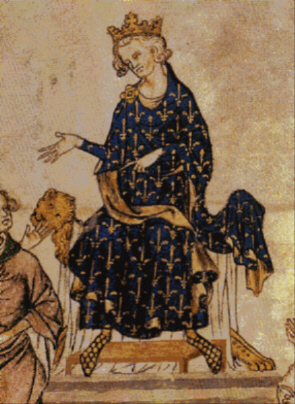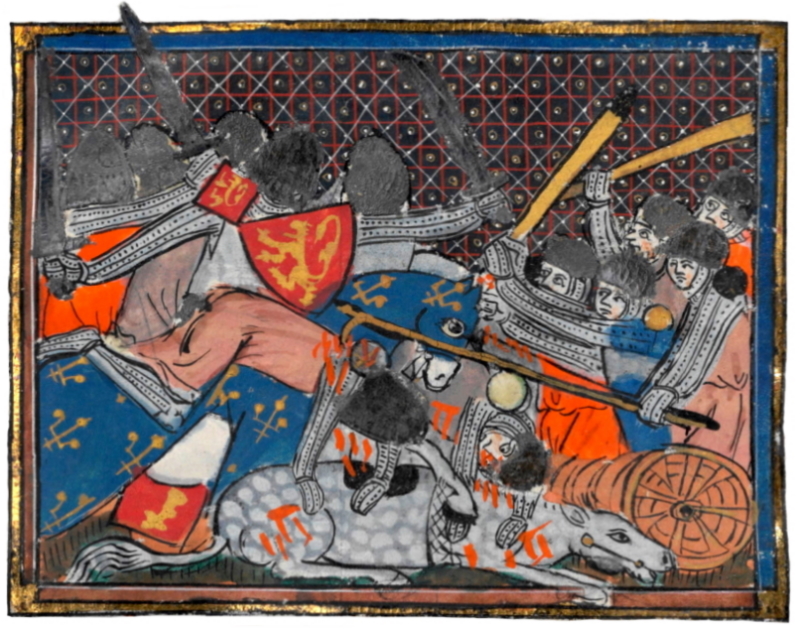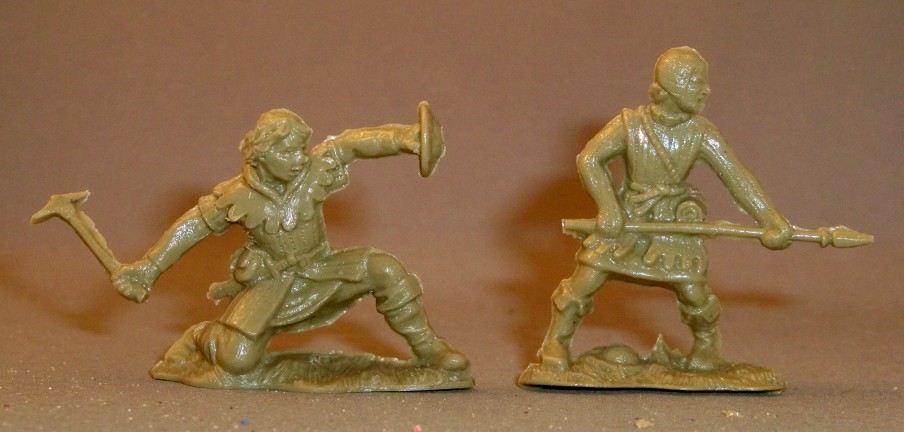Crécy was a battle in which an Anglo-Welsh army of 9,000 to 15,000 (depending on source), commanded by Edward III of England and heavily  outnumbered by Philip VI of France's force of 35,000 to 100,000 (depending on source)
outnumbered by Philip VI of France's force of 35,000 to 100,000 (depending on source) , was victorious as a result of superior weaponry and tactics, demonstrating the importance of the modern military concept of fire power. The
, was victorious as a result of superior weaponry and tactics, demonstrating the importance of the modern military concept of fire power. The  effectiveness of the English longbow, used en masse, was proven against armoured knights, contrary to the
effectiveness of the English longbow, used en masse, was proven against armoured knights, contrary to the  conventional wisdom of the day which held that archers would be ineffective and be butchered when the armoured units closed in.
conventional wisdom of the day which held that archers would be ineffective and be butchered when the armoured units closed in.
 outnumbered by Philip VI of France's force of 35,000 to 100,000 (depending on source)
outnumbered by Philip VI of France's force of 35,000 to 100,000 (depending on source) , was victorious as a result of superior weaponry and tactics, demonstrating the importance of the modern military concept of fire power. The
, was victorious as a result of superior weaponry and tactics, demonstrating the importance of the modern military concept of fire power. The  effectiveness of the English longbow, used en masse, was proven against armoured knights, contrary to the
effectiveness of the English longbow, used en masse, was proven against armoured knights, contrary to the  conventional wisdom of the day which held that archers would be ineffective and be butchered when the armoured units closed in.
conventional wisdom of the day which held that archers would be ineffective and be butchered when the armoured units closed in.
In the battle, the French knights, protected by mail reinforced with plate, nearly exhausted by charging several miles into the fray (against their king's wishes) and having to walk through a quagmire of mud to charge up a shallow hill into English and Welsh arrow storms, were cut down. The result was that much of the French nobility died, perhaps even a third (estimates of the actual numbers in each army vary considerably, depending on the source).
The result was that much of the French nobility died, perhaps even a third (estimates of the actual numbers in each army vary considerably, depending on the source).
 The result was that much of the French nobility died, perhaps even a third (estimates of the actual numbers in each army vary considerably, depending on the source).
The result was that much of the French nobility died, perhaps even a third (estimates of the actual numbers in each army vary considerably, depending on the source).
Knights' armour had not yet evolved to the stage where longbows could not penetrate, and the knights' horses were barely protected at all. The storm of arrows killed or disabled the knights' mounts, and left the knights floundering in the mud on foot beneath an unavoidable hail of arrows.

Just as importantly, the bolts of the hired Genoese crossbowmen who were at the forefront of the battle were unable to reach the defending English. Their quarrels fell short of the English because the Genoese's crossbow's strings were wet and they had misjudged the range and shot too early and too low. The English, controlling the high ground, were able to run a short distance down the hill and easily pick off the Genoese with volleys of arrows. As the Genoese attempted to retreat, they were cut down by the French knights, who considered the withdrawal to be cowardly, and this wasted the first Conroi charge of French cavalry on the Genoese, leaving them disorganized for the charge on the English.
The English, controlling the high ground, were able to run a short distance down the hill and easily pick off the Genoese with volleys of arrows. As the Genoese attempted to retreat, they were cut down by the French knights, who considered the withdrawal to be cowardly, and this wasted the first Conroi charge of French cavalry on the Genoese, leaving them disorganized for the charge on the English.
 The English, controlling the high ground, were able to run a short distance down the hill and easily pick off the Genoese with volleys of arrows. As the Genoese attempted to retreat, they were cut down by the French knights, who considered the withdrawal to be cowardly, and this wasted the first Conroi charge of French cavalry on the Genoese, leaving them disorganized for the charge on the English.
The English, controlling the high ground, were able to run a short distance down the hill and easily pick off the Genoese with volleys of arrows. As the Genoese attempted to retreat, they were cut down by the French knights, who considered the withdrawal to be cowardly, and this wasted the first Conroi charge of French cavalry on the Genoese, leaving them disorganized for the charge on the English.
The battle is seen by many historians as marking the beginning of the end of classic chivalry, although the earlier battle of the Golden Spurs could also be viewed in this light; during the course of the battle, The reason for the battle was a French attempt to subdue the County of Flanders, which was formally part of the French kingdom and added to the crown lands in
battle of the Golden Spurs could also be viewed in this light; during the course of the battle, The reason for the battle was a French attempt to subdue the County of Flanders, which was formally part of the French kingdom and added to the crown lands in  1297 but resisted centralist French policies. In 1300, the French king Philip IV appointed Jacques de Châtillon(above) as governor of Flanders and took the Count of Flanders, Guy of Dampierre,
1297 but resisted centralist French policies. In 1300, the French king Philip IV appointed Jacques de Châtillon(above) as governor of Flanders and took the Count of Flanders, Guy of Dampierre, hostage. This caused considerable unrest among the influential Flemish urban guilds.
hostage. This caused considerable unrest among the influential Flemish urban guilds.
 battle of the Golden Spurs could also be viewed in this light; during the course of the battle, The reason for the battle was a French attempt to subdue the County of Flanders, which was formally part of the French kingdom and added to the crown lands in
battle of the Golden Spurs could also be viewed in this light; during the course of the battle, The reason for the battle was a French attempt to subdue the County of Flanders, which was formally part of the French kingdom and added to the crown lands in  1297 but resisted centralist French policies. In 1300, the French king Philip IV appointed Jacques de Châtillon(above) as governor of Flanders and took the Count of Flanders, Guy of Dampierre,
1297 but resisted centralist French policies. In 1300, the French king Philip IV appointed Jacques de Châtillon(above) as governor of Flanders and took the Count of Flanders, Guy of Dampierre, hostage. This caused considerable unrest among the influential Flemish urban guilds.
hostage. This caused considerable unrest among the influential Flemish urban guilds.After being exiled from their homes by French troops, the citizens of Bruges went back to the city and murdered every Frenchman they could find on May 18, 1302, an act known as the Brugse Metten.
went back to the city and murdered every Frenchman they could find on May 18, 1302, an act known as the Brugse Metten. According to legend, they identified the French by asking them to pronounce a Dutch phrase, schilt ende vriend (shield and friend) and everyone who had a problem pronouncing this shibboleth was killed.
According to legend, they identified the French by asking them to pronounce a Dutch phrase, schilt ende vriend (shield and friend) and everyone who had a problem pronouncing this shibboleth was killed.
 went back to the city and murdered every Frenchman they could find on May 18, 1302, an act known as the Brugse Metten.
went back to the city and murdered every Frenchman they could find on May 18, 1302, an act known as the Brugse Metten. According to legend, they identified the French by asking them to pronounce a Dutch phrase, schilt ende vriend (shield and friend) and everyone who had a problem pronouncing this shibboleth was killed.
According to legend, they identified the French by asking them to pronounce a Dutch phrase, schilt ende vriend (shield and friend) and everyone who had a problem pronouncing this shibboleth was killed.
many of the prisoners and wounded were killed. This was against the chivalric codes of warfare, and knights on horseback were no longer "undefeatable" by infantry.



No comments:
Post a Comment